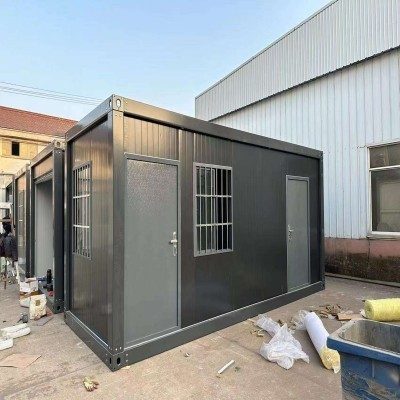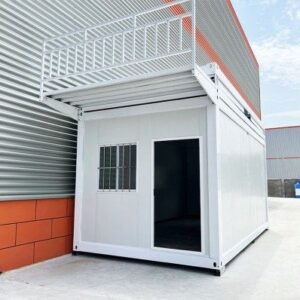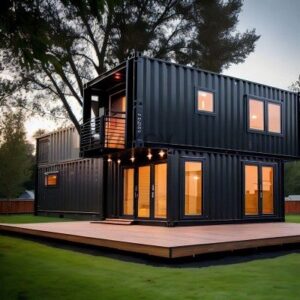If you’re thinking about turning a shipping container into a cozy, energy-efficient home, insulating a shipping container house is absolutely crucial. Without the right insulation, you’re facing extreme heat in summer, bone-chilling cold in winter, and relentless condensation problems. But here’s the good news: with the right techniques and materials, you can transform a metal box into a comfortable, sustainable living space. In this guide, you’ll get clear, practical advice on how to insulate a shipping container house—covering everything from moisture barriers to budget-friendly options. Ready to make your container home comfortable year-round? Let’s get started!
Unique Insulation Challenges of Shipping Container Houses
When it comes to how to insulate a shipping container house, understanding the unique insulation challenges is critical. Unlike traditional homes, shipping containers are made of steel, a highly conductive metal that significantly affects heat transfer. This metal surface easily absorbs heat in hot weather and loses it quickly in cold conditions, creating major fluctuations in indoor temperatures. This makes shipping container house thermal insulation a more complex task compared to regular wood-framed buildings.
Metal Container Properties Affecting Heat Transfer
Steel containers act like giant heat sinks, meaning:
- Heat transfers rapidly through the metal walls, causing the interior to become very hot in summer and cold in winter.
- The container’s thin metal walls offer minimal natural thermal resistance.
- Extreme temperature swings on the container’s surface demand insulation materials with high R-values to maintain indoor comfort.
Issues with Condensation and Moisture Buildup
Condensation is a common and critical problem in container homes because:
- Warm, moist air inside meets the cold metal walls, leading to moisture buildup.
- This moisture can cause rust, mold, and deterioration of both the container structure and insulation materials.
- Proper vapor barriers and moisture management strategies are essential to avoid these issues.
Temperature Extremes in Different Climates
Shipping container houses face wide-ranging temperature extremes depending on location:
- In hot climates, steel containers absorb excessive heat, making interiors uncomfortable without proper reflective and insulative layers.
- In cold climates, heat loss through the metal walls causes high energy consumption for heating.
- Insulating for these temperature challenges requires careful material selection balanced with budget and climate considerations.
Why Traditional Home Insulation Methods Aren’t Always Suitable
Traditional insulation techniques designed for wood-framed or concrete houses don’t always apply to containers:
- Conventional batt insulation like fiberglass or mineral wool may not perform well against condensation on metal.
- Containers require special attention to vapor barriers, sealing, and thermal bridging to prevent moisture and heat loss.
- Rigid foam or spray foam insulation is often favored for their ability to seal air leaks and provide continuous thermal resistance on metal surfaces.
The unique physical and environmental factors of shipping container homes mean that the best insulation for shipping container homes must address these challenges head-on, combining moisture control, thermal resistance, and adaptability to temperature extremes for a durable, comfortable living space.
For a comprehensive guide on converting and building container houses, you can also explore how to convert shipping container to house.
Step by Step Process to Insulate a Shipping Container House
Prepare the Container Interior
Before adding any insulation, thoroughly clean the interior of your shipping container. This means removing dirt, grease, and rust spots. Rust proofing is essential because metal containers are prone to corrosion, especially in humid climates. Use a rust-inhibiting primer or paint to protect the steel surfaces. Also, seal any holes or gaps to prevent drafts and moisture intrusion, which can cause condensation problems later.
Install a Vapor Barrier to Prevent Moisture Issues
A vapor barrier is crucial in controlling moisture inside your container home. Since metal surfaces conduct temperature quickly, moist air can condense on the interior walls. Installing a high-quality vapor barrier on the container’s walls and ceiling prevents moisture buildup and mold formation. Typically, this is a plastic sheet or specialized membrane installed before adding insulation.
Choose and Install Insulation Based on Budget and Climate
Selecting the right insulation depends on your budget, location’s climate, and personal preferences:
- Spray Foam Insulation: Offers excellent air sealing and high R-value but costs more upfront.
- Rigid Foam Board: Easy to install with good thermal resistance; great for DIY projects.
- Blanket Insulation (Fiberglass or Mineral Wool): Affordable but requires framing and vapor barriers.
- Natural Insulation (Sheep Wool, Cellulose): Perfect for eco-conscious builders but often pricier.
Once you choose, install insulation carefully against the vapor barrier, ensuring full coverage without gaps to maximize thermal protection.
Add Framing and Finish Interior Walls
After insulation is in place, build a wood or metal frame inside the container to support your drywall or plasterboard. Framing creates a cavity for insulation and prevents thermal bridging by separating metal walls from interior finishes. It also provides a solid surface to fasten drywall and run electrical wiring or plumbing.
Ensure Proper Ventilation for Moisture and Air Quality Control
Good ventilation is key to maintaining air quality and reducing humidity inside your container home. Alongside insulation, install vents, fans, or an HVAC system that supports air exchange without losing heat. This helps avoid condensation buildup and keeps your living space comfortable year-round. Consider integrating ventilation with your insulation choice to optimize energy efficiency.
Additional Considerations for Effective Shipping Container House Insulation
When insulating a shipping container house, there are some key details beyond just picking a material. Addressing these will boost thermal insulation, control moisture, and improve comfort throughout the year.
Minimize Thermal Bridging
Thermal bridging happens when the steel container’s metal frame allows heat to pass through, cutting down your insulation’s effectiveness. To reduce this:
- Use continuous insulation layers over framing to block metal from directly connecting inside and outside.
- Add thermal breaks, like furring strips or insulated panels between the container walls and your interior finishes.
- Avoid gaps where metal touches insulation directly, which can create cold or hot spots and increase energy loss.
Properly tackling thermal bridging is critical for consistent shipping container house thermal insulation and lowering heating and cooling costs.
Seal All Edges Corners and Penetrations
The metal construction and tight corners in containers can leave small gaps or joints that let air and moisture sneak in. Tight sealing is essential for:
- Preventing drafts and heat leaks.
- Avoiding condensation buildup that can lead to rust and mold.
- Keeping pests out.
Use high-quality sealants and weatherstripping at all joints, corners, door frames, and any wall penetrations such as electrical boxes or plumbing. A thorough seal enhances insulation performance and overall home durability.

Soundproofing Benefits of Insulation Choices
Besides temperature control, insulation can significantly improve soundproofing for shipping container walls. Metal walls tend to transmit noise easily, so consider:
- Spray foam insulation which adds both thermal and acoustic barriers.
- Mineral wool or fiberglass batts that have good sound-dampening properties.
- Adding resilient channels or sound isolation clips behind drywall can further reduce noise from outside or neighboring rooms.
Soundproofing is often overlooked but makes a big difference in daily living comfort, especially in urban or noisy environments.
Integrate Insulation with HVAC Systems
Insulation and HVAC need to work hand-in-hand for best results. Consider these when planning your container home’s climate control:
- Ensure proper ventilation to prevent moisture buildup behind insulation, especially in tight metal structures.
- Coordinate insulation R-value with HVAC capacity to avoid over- or under-sizing your heating and cooling systems.
- Use vapor barriers appropriately so HVAC humidity control can function efficiently.
- Plan ductwork or air returns within or alongside insulated spaces without compromising the insulation layer.
When done right, integrating insulation with your HVAC system will keep your container home comfortable year-round while reducing energy bills.
Cost Analysis for Shipping Container House Insulation
When budgeting for shipping container house insulation, understanding the cost differences among insulation types and installation methods is key. Each option varies in price, effectiveness, and labor needs, so having a clear overview helps you make smart spending decisions.
Comparing Insulation Material Costs
| Insulation Type | Average Material Cost (per sq ft) | Pros | Cons |
|---|---|---|---|
| Spray Foam | $1.50 – $3.50 | Excellent air seal, high R-value | Higher cost, professional install required |
| Rigid Foam Board | $0.70 – $2.00 | Easy to install, moisture resistant | Gaps can lead to thermal bridging |
| Blanket (Fiberglass/Mineral Wool) | $0.30 – $1.00 | Affordable, soundproofing benefits | Can absorb moisture if not sealed properly |
| Natural (Sheep Wool/Cellulose) | $0.90 – $2.50 | Eco-friendly, breathable | Less common, might need local sourcing |
Keep in mind these are material costs only. Installation and prep work can add significantly, especially for spray foam.
DIY vs Professional Installation Costs
- DIY Installation
- Materials only, lower upfront cost
- Requires tools, time, and skill to ensure proper sealing and vapor barrier installation
- Risk of poor insulation performance if not done correctly
- Best for rigid foam board or blanket insulation
- Professional Installation
- Includes labor, prep, and cleanup
- Ensures proper application (especially for spray foam)
- Costs can double or triple material price depending on region and project size
- Worth considering for time savings and quality
Potential Rebates and Incentives for Energy Efficient Container Homes
To offset costs, check for:
- Federal and State Energy Efficiency Rebates – Some states offer tax credits or rebates for using high-performance insulation or converting shipping containers into energy-efficient homes.
- Local Utility Company Programs – These sometimes provide discounts or rebates for insulation upgrades.
- Green Building Incentives – If you’re using eco-friendly materials (like sheep wool or cellulose), look for additional incentives supporting sustainable building practices.
Staying updated on available programs can save you hundreds to thousands on your shipping container insulation cost.
Maintenance and Long Term Care of Shipping Container House Insulation
Proper maintenance of shipping container insulation is crucial to keep your container home comfortable and energy-efficient over time. Since metal containers are prone to moisture buildup and temperature swings, regular checks and care are necessary.
Monitor for Moisture and Mold
- Check for condensation and damp spots inside walls and ceilings regularly. Moisture traps mold, which damages insulation and indoor air quality.
- Use a moisture meter or look for visual signs like discoloration or musty odors.
- Pay close attention to corners, seams, and near plumbing or HVAC penetrations where water is likely to accumulate.
- Maintain proper ventilation and dehumidification to reduce moisture risk.
Repair Tips for Damaged Insulation
- If you find damp or moldy insulation, remove and replace the affected sections promptly.
- For spray foam or rigid foam insulation, patch holes or cracks using compatible foam sealants to restore thermal integrity.
- Fix any leaks or rust spots on the container’s shell to prevent water intrusion in the future.
- After repairs, reinspect vapor barriers and reseal if necessary to keep moisture out.
Upgrades and Retrofitting Insulation After Initial Build
- As technology improves or your climate needs change, consider adding extra layers of insulation to increase R-value.
- Retrofits like adding rigid foam boards over existing insulation before finishing walls can boost thermal performance with minimal demolition.
- Explore eco-friendly insulation upgrades such as cellulose or sheep wool for better breathability and sustainability.
- Upgrading insulation can also benefit soundproofing and overall comfort.
Consistent upkeep and smart retrofitting keep your shipping container home well insulated, dry, and energy efficient for years to come



